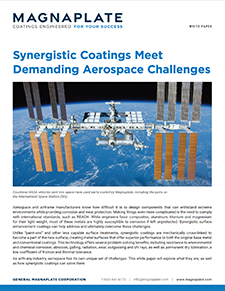
White Papers
Sustainable Engineered Coatings Greatly Extend Equipment Lifetimes
For plant engineers and maintenance supervisors, minimizing downtime and keeping equipment online is a top priority. High productivity and cost effective manufacturing are the result of well-maintained plant assets, which are the primary focus of those in the maintenance, repair and operations (MRO) community. However, in addition to 24/7 production schedules, plant supervisors must also pay attention to cost considerations and environmental concerns. Balancing these demands means employing multiple strategies including adherence to a strict policy of repairing equipment rather than replacing it, for as long as possible.
Engineered Coatings Boost Productivity in Automated Systems
Higher throughput, seamless operation, 24/7 plant schedules and cost effective manufacturing are key benefits of automation. In reality, these performance benchmarks can only be achieved by correctly specified and well-maintained equipment. From robotic systems to material handling and packaging machinery, keeping automated equipment up and running is often the most important job for engineers and plant supervisors. Issues involving abrasion, premature wear, galling, corrosion and sticking must be continually identified and mitigated to keep equipment online.
Synergistic Coatings Meet Demanding Aerospace Challenges
Aerospace and airframe manufacturers know how difficult it is to design components that can withstand extreme environments while providing corrosion and wear protection. Making things even more complicated is the need to comply with international standards, such as REACH. While engineers favor composites, aluminum, titanium and magnesium for their light weight, most of these metals are highly susceptible to corrosion if left unprotected. A new white paper explores how applying synergistic surface enhancement coatings can address and overcome these industry challenges.
Choose Surface Treatments Early To Avoid Future Problems
Too often the coating of parts is an afterthought for design engineers. Rather than being a part of the discussion in the early stages of design, designers try to solve problems with coatings at the point of manufacturing—or even after manufacturing. While each type of surface treatment provides its own unique set of properties and benefits, each of these processes also has limitations that should be addressed early on in the design process to ensure optimal performance.
Engineered Coatings Boost Uptime and Cleanliness in Food Processing Applications
As the food processing industry continues to expand globally, food and beverage producers must rely on highly sophisticated automated equipment to meet consumer demand. Companies that manufacture everything from bakery items and frozen food to meat and poultry products are continuing to specify new equipment and upgrade older machinery to meet market needs.
Coatings Keep Converting Lines Humming
Whenever you drive fabrics, films or paper good at high speeds, tearing and sticking can create all kinds of engineering and productivity headaches. And one way to get rid of them is by applying the right type of engineered coatings to key machine components.
Engineered Coatings Minimize Downtime, Improve Sanitation in Medical and Pharmaceutical Applications
Processing and packaging applications in the food and drug industries have many criteria in common, because both industries must meet stringent standards developed to guarantee the utmost safety of products intended for human consumption. Production methods must also be as efficient and cost- effective as possible, maximizing throughput and minimizing downtime.
Engineered Coatings Alleviate Drill Tooling Wear
With today’s oil and gas wells pushing deeper and deeper, metal drilling tools have to contend with increasingly corrosive conditions. Deep wells not only tend to exhibit concentrations of sour gas but also subject drilling tools to high temperature and pressures. Making matters worse, the rotary action of drilling exposes tools to constant wear. Offshore conditions are even more challenging given the difficulty and cost of maintaining drill strings.
Engineered Coatings Boost Throughput, Solve Problems in Packaging Applications
Keeping packaging equipment up and running is top priority for engineers and plant personnel. Faced with ever-increasing productivity benchmarks based on fast and efficient operation, packaging engineers must continually fight against issues such as sticking, premature wear, abrasion and corrosion. To eliminate these challenges, nano-engineered coatings are being used to protect machine components and solve performance problems in food, pharmaceutical and consumer goods packaging.








